Schrödinger Bundle
How Does Schrödinger Company Revolutionize Science?
Schrödinger, Inc. (Nasdaq: SDGR) is at the forefront of transforming drug discovery and materials science with its cutting-edge, physics-based computational platform. Its innovative approach, blending physics-based modeling with machine learning, is designed to accelerate the identification and optimization of molecules. The company's impact is evident through collaborations with leading pharmaceutical, biotechnology, and chemical companies.
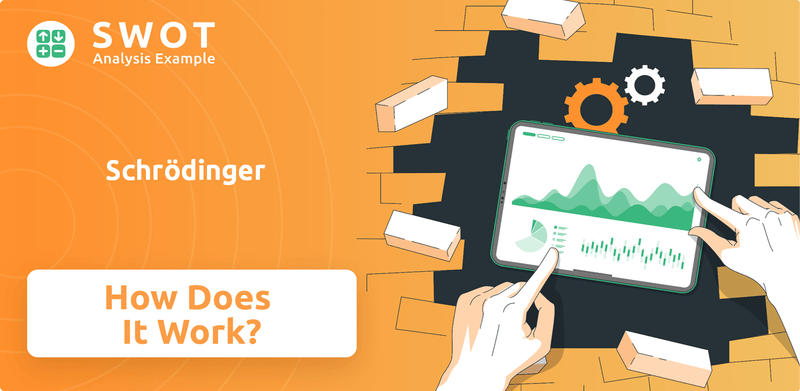
With total revenue reaching $59.6 million in Q1 2025, representing a 63% year-over-year increase, Schrödinger Company demonstrates strong financial health and market adoption. This growth highlights the increasing importance of computational solutions in research and development. To better understand the company's strategic advantages, explore the Schrödinger SWOT Analysis, which offers valuable insights into its strengths, weaknesses, opportunities, and threats within the competitive landscape of computational chemistry and drug discovery. The Schrödinger software is a key component of their success.
What Are the Key Operations Driving Schrödinger’s Success?
The core operations of the Schrödinger Company revolve around its advanced, physics-based computational platform. This platform is designed for molecular discovery and design, primarily within the pharmaceutical, biotechnology, and materials research sectors. The Schrödinger software enables scientists to predict the properties of molecules and materials with a high degree of accuracy, which significantly accelerates the research and development (R&D) process.
The company serves a diverse customer base, including pharmaceutical companies, biotech firms, academic researchers, and government laboratories. Its operational processes include sophisticated technology development, particularly in areas like molecular dynamics simulations, free energy calculations, and virtual screening tools. Additionally, Schrödinger offers an Enterprise Informatics Platform called LiveDesign, which facilitates communication among interdisciplinary research teams. Beyond software, the company engages in drug discovery projects, both internally and through collaborations.
This dual approach allows Schrödinger to generate revenue from software licensing and from milestone payments and royalties through its drug discovery partnerships. This integrated strategy combines cutting-edge computational modeling, machine learning, and molecular dynamics simulations to explore vast chemical spaces and design compounds with desired properties. The company's significant, computationally derived database of molecules creates a barrier to entry for competitors.
Schrödinger's platform utilizes molecular dynamics simulations, free energy calculations, and quantum mechanics calculations. These technologies are crucial for predicting molecular properties.
The company serves pharmaceutical companies, biotech firms, academic researchers, and government laboratories. This diverse customer base highlights the broad applicability of the Schrödinger platform.
Revenue is generated through software licensing, milestone payments, and royalties from drug discovery partnerships. The dual revenue model provides financial stability.
Strategic partnerships with companies like Novartis and Eli Lilly integrate innovations directly into drug development pipelines. These partnerships are crucial for market penetration.
The value proposition of Schrödinger lies in its ability to significantly reduce the time and cost of bringing new drugs and materials to market. This is achieved through its advanced computational capabilities and strategic partnerships. The company's integrated approach, combining computational modeling and machine learning, creates a formidable competitive advantage.
- Reduced R&D Costs: By using computational methods, the company helps reduce the need for expensive and time-consuming laboratory experiments.
- Faster Time to Market: The platform accelerates the drug discovery process, allowing new drugs to reach the market more quickly.
- Improved Efficiency: The company's software enhances the efficiency of preclinical development.
- Strong Partnerships: Collaborations with major pharmaceutical companies validate the company's technology and expand its reach.
Schrödinger SWOT Analysis
- Complete SWOT Breakdown
- Fully Customizable
- Editable in Excel & Word
- Professional Formatting
- Investor-Ready Format
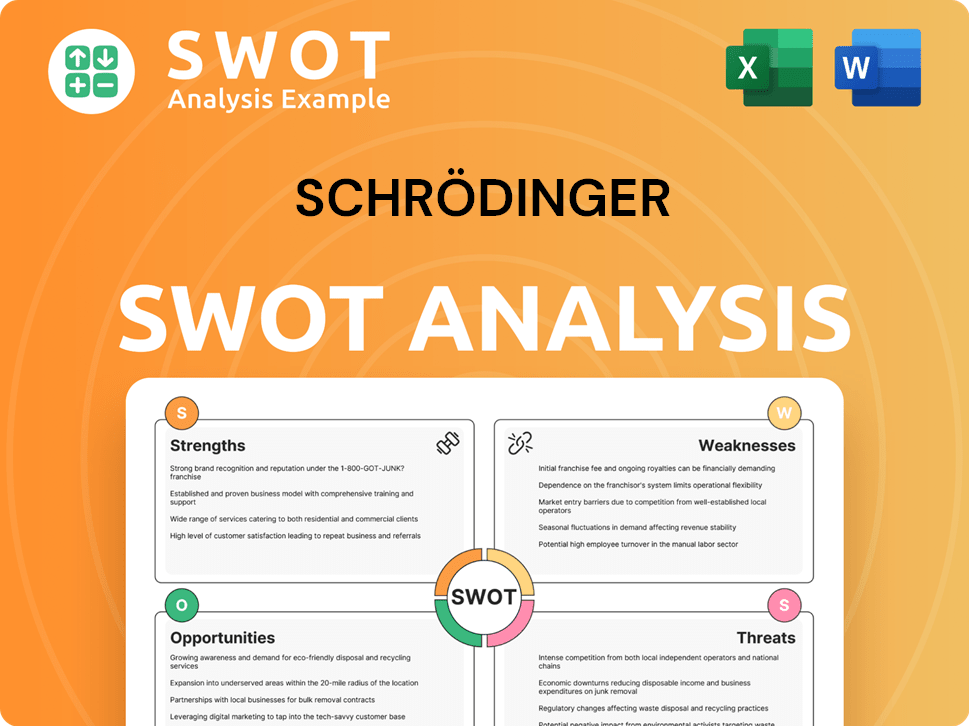
How Does Schrödinger Make Money?
The Schrödinger Company generates revenue through two main segments: Software and Drug Discovery. The company's financial performance is significantly influenced by its software sales and its collaborations in drug discovery. Understanding these revenue streams is crucial for evaluating the company's financial health and growth potential.
In 2024, the company's total revenue was $207.5 million, with software accounting for the majority. The company employs various monetization strategies, including a software-as-a-service (SaaS) model and partnerships in drug discovery. These strategies aim to ensure a steady revenue flow and expand the company's market presence.
In Q1 2025, total revenue increased significantly, driven by growth in both software and drug discovery segments. This demonstrates the effectiveness of the company's strategic initiatives and its ability to capitalize on market opportunities. The company's focus on recurring revenue and collaborative partnerships is key to its financial success.
Software revenue is a primary revenue stream for the Schrödinger Company. The Schrödinger software segment is crucial for the company's financial performance. It is essential for understanding the company's overall revenue strategy.
Drug discovery revenue comes from the company's internal programs and collaborative partnerships. These partnerships are key to the company's revenue model. The company's drug discovery segment is an important part of its overall strategy.
The software-as-a-service (SaaS) model is a key monetization strategy for the company. This model helps in lowering customer acquisition costs. It also benefits from recurring revenue streams.
Collaborative partnerships play a crucial role in the company's revenue generation. These partnerships involve co-developing drug candidates and innovative materials. They often include upfront payments and milestone payments.
The company receives upfront payments and milestone payments from its collaborations. The Novartis agreement is a prime example of this. These payments contribute significantly to the company's revenue.
Hosted software contracts are increasing, contributing to recurring revenue. Hosted contracts made up 20% of software revenue in 2024. This shift supports a more predictable revenue model.
The Schrödinger Company's revenue streams and monetization strategies are multifaceted, designed to ensure financial stability and growth. The Schrödinger software business, with its SaaS model, is a significant driver of revenue, supported by the company's drug discovery collaborations. The company's strategic partnerships, such as the one with Novartis, demonstrate its ability to secure substantial upfront and milestone payments, contributing to revenue growth. Furthermore, the expansion of hosted software contracts indicates a shift towards a more predictable, recurring revenue model. For more details on the company's origins and development, you can read the Brief History of Schrödinger.
Here's a breakdown of the company's financial performance:
- 2024 Total Revenue: $207.5 million, a decrease of 4.2% from 2023.
- 2024 Software Revenue: $180.4 million, a 13.3% increase from 2023, representing approximately 86.9% of total revenue.
- 2024 Drug Discovery Revenue: $27.2 million, a decrease from $57.5 million in 2023.
- Q1 2025 Total Revenue: $59.6 million, a 63% increase year-over-year.
- Q1 2025 Software Revenue: $48.8 million, a 46% growth compared to Q1 2024.
- Q1 2025 Drug Discovery Revenue: $10.7 million, a 237% increase from Q1 2024.
- Novartis Collaboration: $150 million upfront payment with potential milestone payments up to $2.3 billion.
- Bill & Melinda Gates Foundation Grant: $19.5 million for toxicology risk prediction.
Schrödinger PESTLE Analysis
- Covers All 6 PESTLE Categories
- No Research Needed – Save Hours of Work
- Built by Experts, Trusted by Consultants
- Instant Download, Ready to Use
- 100% Editable, Fully Customizable
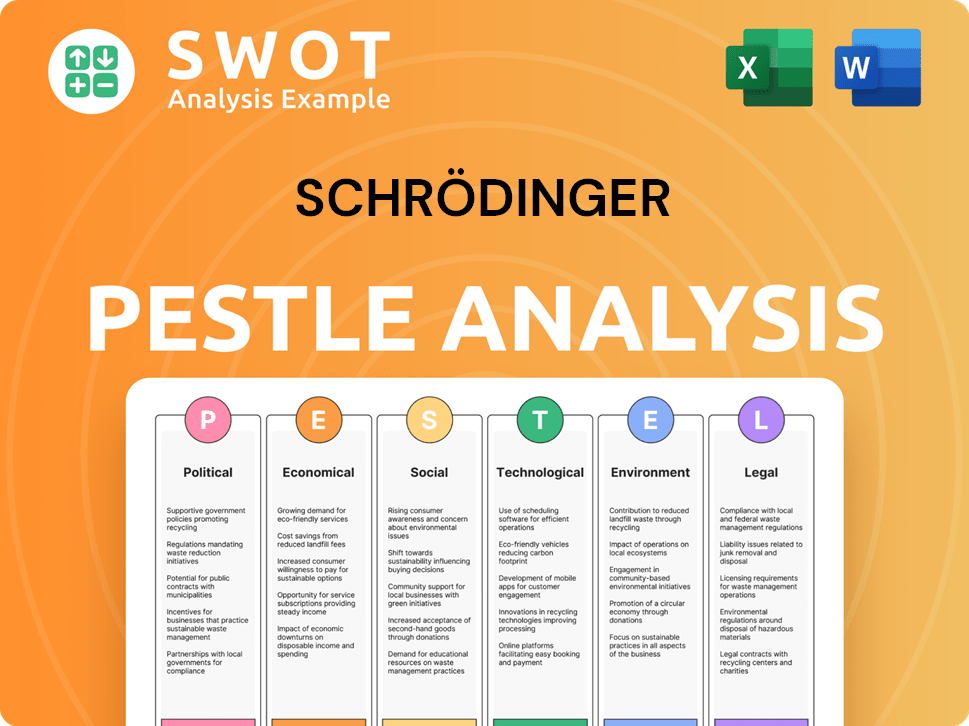
Which Strategic Decisions Have Shaped Schrödinger’s Business Model?
Schrödinger has achieved significant milestones that have shaped its operations and financial performance. Key strategic moves and advancements in its computational platform have solidified its position in the drug discovery and development sector. The company's focus on partnerships and technological innovation continues to drive its growth.
A notable strategic move in Q1 2025 was the expansion of its research collaboration with Eli Lilly and Company, building on previous agreements. In January 2025, Schrödinger also received a $150 million upfront payment from Novartis following antitrust regulatory clearance for their multi-target research collaboration, which could include up to $2.3 billion in milestone payments. These collaborations highlight Schrödinger's ability to secure significant partnerships and funding.
Operationally, Schrödinger launched LiveDesign Biologics in 2024, an informatics solution for drug discovery teams designing biologics, expanding its existing small molecule-focused LiveDesign offering. The company also initiated a program in 2024 to expand its computational platform for predictive toxicology, supported by a $19.5 million grant from the Bill & Melinda Gates Foundation. This initiative is expected to launch for select customers in the latter half of 2025.
Schrödinger's key milestones include the expansion of research collaborations with major pharmaceutical companies and the launch of innovative software solutions. These milestones demonstrate the company's ability to secure strategic partnerships and develop cutting-edge technology. The expansion of the computational platform for predictive toxicology, backed by significant grants, is a testament to its commitment to innovation.
Strategic moves include the expansion of research collaborations and the development of new software offerings. The company's focus on partnerships with pharmaceutical giants like Novartis and Eli Lilly provides access to funding and resources. The launch of LiveDesign Biologics further strengthens its position in the drug discovery market. These moves are detailed in the Marketing Strategy of Schrödinger.
Schrödinger's competitive advantages are rooted in its advanced physics-based computational platform, which offers accurate and efficient molecular modeling solutions, accelerating drug discovery and development. The company's vast, computationally derived database of molecules creates a strong barrier to entry. Its integrated approach, combining computational modeling, machine learning, and molecular dynamics simulations, differentiates it from competitors.
The company's high customer retention rate, reported at 99.9% among large customers as of Q1 2025, underscores its competitive strength. The $150 million upfront payment from Novartis and potential milestone payments of up to $2.3 billion highlight the financial potential of its collaborations. Schrödinger is also advancing its proprietary therapeutic programs, with initial Phase 1 data expected from three lead programs (SGR-1505, SGR-2921, and SGR-3515) in 2025.
Schrödinger continues to adapt to new trends and technology shifts, including the increasing integration of AI and machine learning into its platform. This is evident in its predictive toxicology initiative and its focus on cloud-based software solutions. Hosted contracts contribute a growing share of software revenue, showing the company's ability to adapt to market demands.
- Schrödinger software offers advanced molecular modeling capabilities.
- The company's platform integrates computational chemistry and drug discovery.
- Schrödinger's competitive edge lies in its advanced computational platform.
- The company's high customer retention rate indicates strong market position.
Schrödinger Business Model Canvas
- Complete 9-Block Business Model Canvas
- Effortlessly Communicate Your Business Strategy
- Investor-Ready BMC Format
- 100% Editable and Customizable
- Clear and Structured Layout
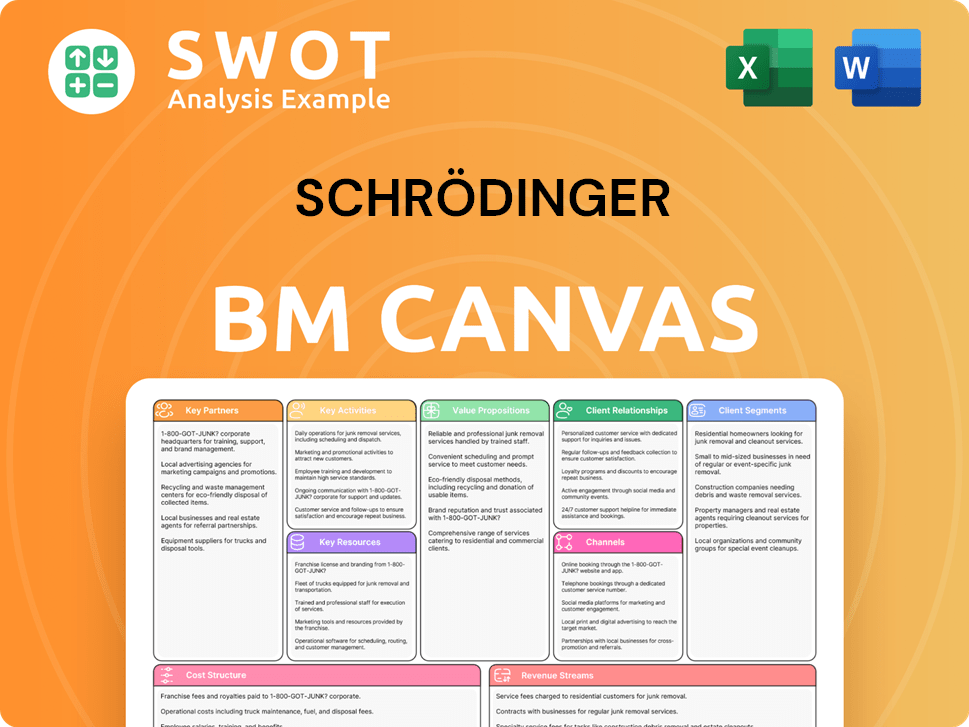
How Is Schrödinger Positioning Itself for Continued Success?
The Schrödinger Company holds a prominent position in the computational chemistry and drug discovery sectors. Its physics-based Schrödinger software platform is used by all of the top 20 biopharma companies globally. This widespread adoption highlights the company's significant influence and the value its platform provides to the industry.
However, the company navigates various challenges, including market volatility and high R&D costs. Despite these risks, the company's strategic focus on expanding its software adoption and advancing its drug discovery programs suggests a forward-looking approach. For more insights, you can read about the Growth Strategy of Schrödinger.
Schrödinger's Schrödinger software is a leader in computational chemistry and drug discovery. The Schrödinger platform is used globally, with over 1,750 software customers by the end of 2024. Strategic partnerships with major pharmaceutical firms strengthen its market presence.
Macroeconomic factors could affect Schrödinger software adoption. Drug discovery revenue can be volatile due to milestone-based payments. High R&D costs are a constant challenge, although operating expenses decreased by 5% in Q1 2025 compared to Q1 2024.
Schrödinger anticipates software revenue growth of 10% to 15% for the full year 2025. Drug discovery revenue is projected to be between $45 million and $50 million. The company aims to increase customer adoption and advance its drug discovery programs.
Schrödinger plans to release initial Phase 1 clinical data from its lead proprietary programs in 2025. The company expects a significant reduction in cash used for operating activities in 2025 compared to 2024. Continued investment in R&D, including predictive toxicology, is a priority.
Schrödinger's position in the market is strong, with its Schrödinger software platform being widely used. The company faces risks such as potential market volatility and high R&D expenses. The future outlook is positive, with expected revenue growth and strategic initiatives to enhance its position.
- Strong market presence in computational chemistry and drug discovery.
- Focus on expanding software adoption and advancing drug discovery programs.
- Anticipated revenue growth and strategic investments in R&D.
- Potential impact of regulatory changes, such as the FDA's shift away from preclinical animal testing.
Schrödinger Porter's Five Forces Analysis
- Covers All 5 Competitive Forces in Detail
- Structured for Consultants, Students, and Founders
- 100% Editable in Microsoft Word & Excel
- Instant Digital Download – Use Immediately
- Compatible with Mac & PC – Fully Unlocked
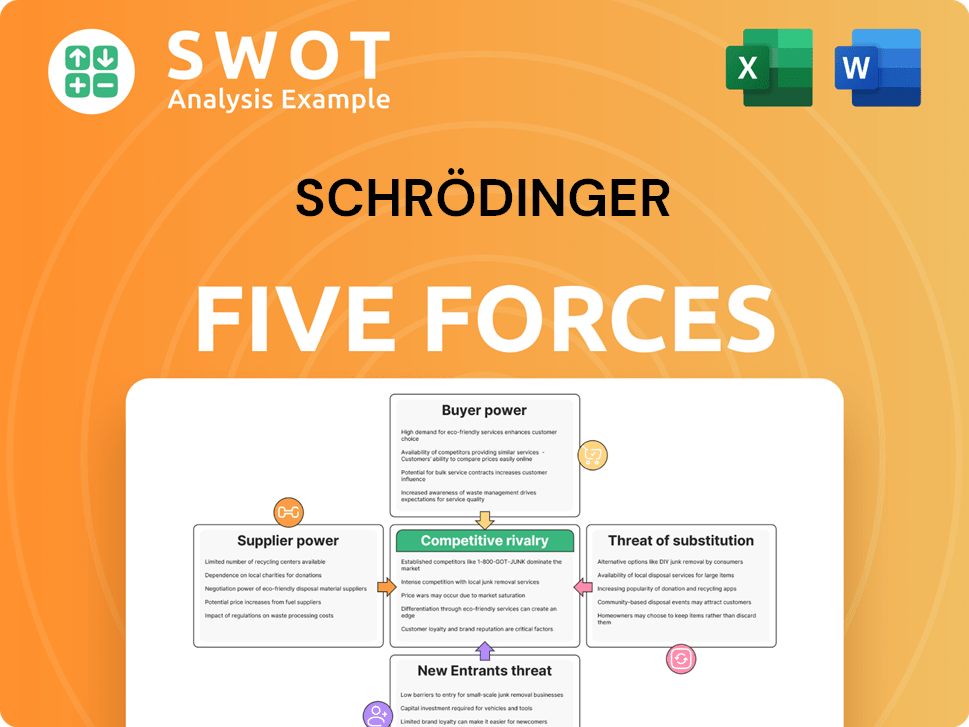
Related Blogs
- What are Mission Vision & Core Values of Schrödinger Company?
- What is Competitive Landscape of Schrödinger Company?
- What is Growth Strategy and Future Prospects of Schrödinger Company?
- What is Sales and Marketing Strategy of Schrödinger Company?
- What is Brief History of Schrödinger Company?
- Who Owns Schrödinger Company?
- What is Customer Demographics and Target Market of Schrödinger Company?
Disclaimer
All information, articles, and product details provided on this website are for general informational and educational purposes only. We do not claim any ownership over, nor do we intend to infringe upon, any trademarks, copyrights, logos, brand names, or other intellectual property mentioned or depicted on this site. Such intellectual property remains the property of its respective owners, and any references here are made solely for identification or informational purposes, without implying any affiliation, endorsement, or partnership.
We make no representations or warranties, express or implied, regarding the accuracy, completeness, or suitability of any content or products presented. Nothing on this website should be construed as legal, tax, investment, financial, medical, or other professional advice. In addition, no part of this site—including articles or product references—constitutes a solicitation, recommendation, endorsement, advertisement, or offer to buy or sell any securities, franchises, or other financial instruments, particularly in jurisdictions where such activity would be unlawful.
All content is of a general nature and may not address the specific circumstances of any individual or entity. It is not a substitute for professional advice or services. Any actions you take based on the information provided here are strictly at your own risk. You accept full responsibility for any decisions or outcomes arising from your use of this website and agree to release us from any liability in connection with your use of, or reliance upon, the content or products found herein.